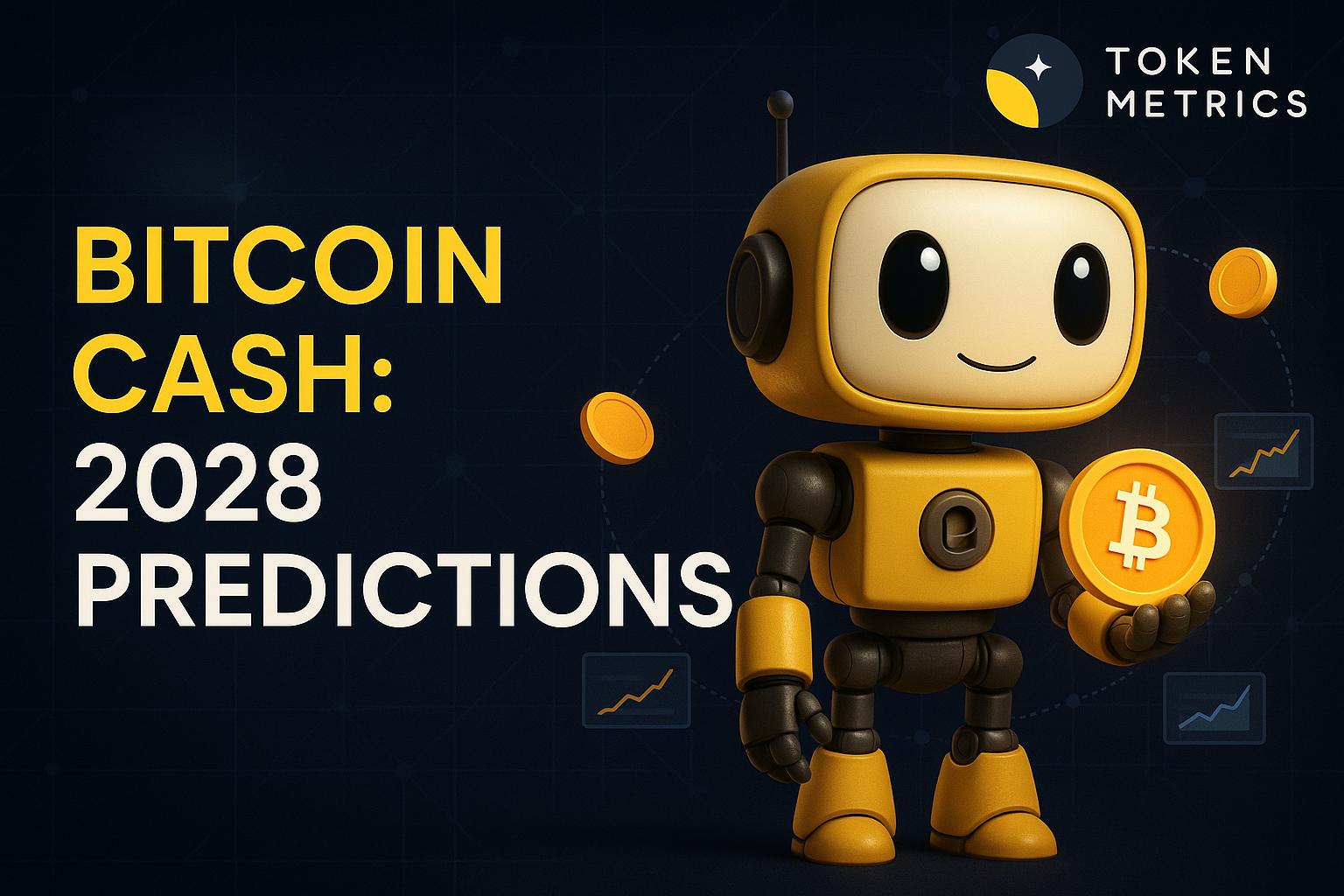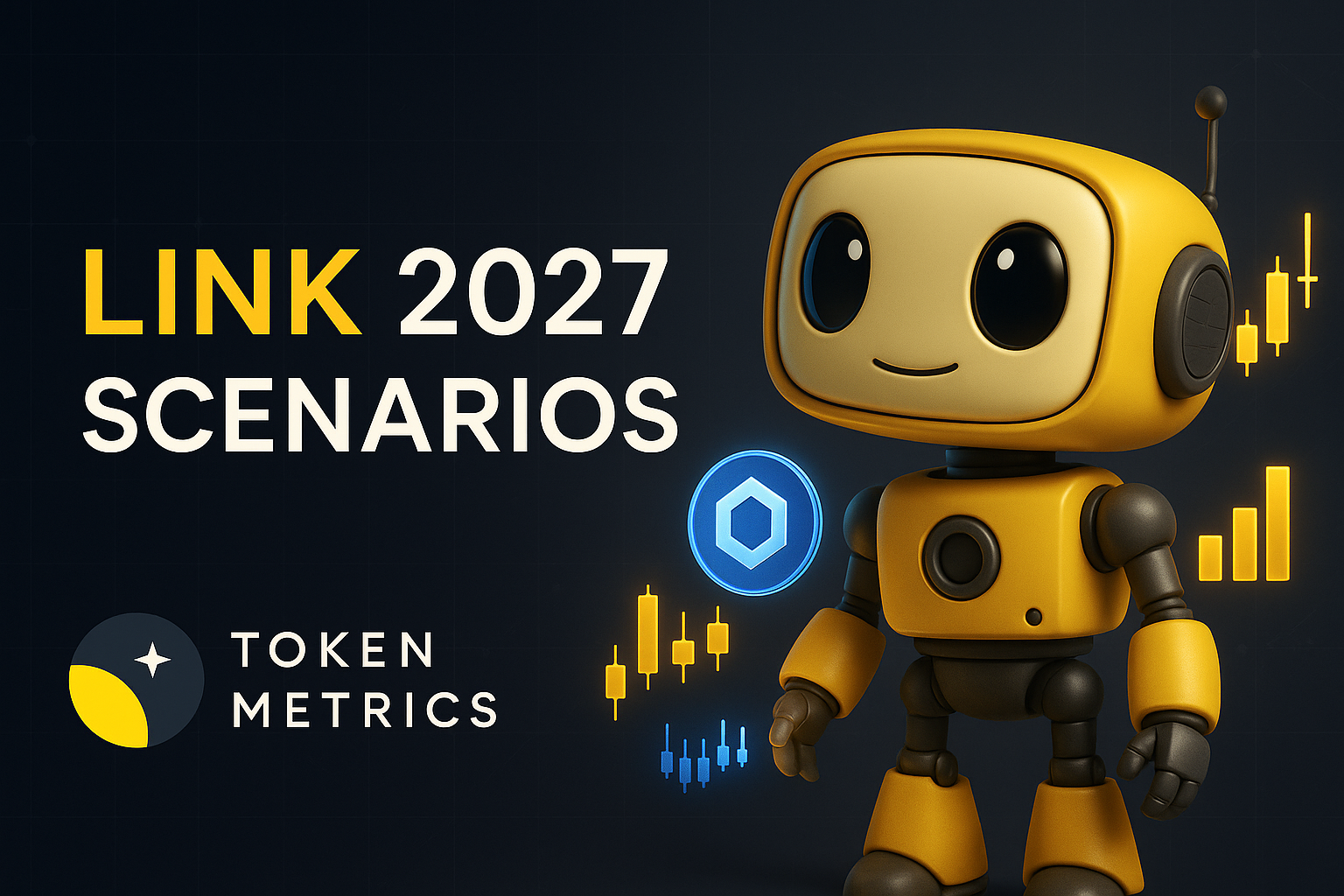Top Crypto Trading Platforms in 2025







%201.svg)
%201.svg)
Big news: We’re cranking up the heat on AI-driven crypto analytics with the launch of the Token Metrics API and our official SDK (Software Development Kit). This isn’t just an upgrade – it's a quantum leap, giving traders, hedge funds, developers, and institutions direct access to cutting-edge market intelligence, trading signals, and predictive analytics.
Crypto markets move fast, and having real-time, AI-powered insights can be the difference between catching the next big trend or getting left behind. Until now, traders and quants have been wrestling with scattered data, delayed reporting, and a lack of truly predictive analytics. Not anymore.
The Token Metrics API delivers 32+ high-performance endpoints packed with powerful AI-driven insights right into your lap, including:
Getting started with the Token Metrics API is simple:
At Token Metrics, we believe data should be decentralized, predictive, and actionable.
The Token Metrics API & SDK bring next-gen AI-powered crypto intelligence to anyone looking to trade smarter, build better, and stay ahead of the curve. With our official SDK, developers can plug these insights into their own trading bots, dashboards, and research tools – no need to reinvent the wheel.
%201.svg)
%201.svg)
Infrastructure protocols become more valuable as the crypto ecosystem scales and relies on robust middleware. Chainlink provides critical oracle infrastructure where proven utility and deep integrations drive long-term value over retail speculation. Increasing institutional adoption raises demand for professional-grade data delivery and security.
Token Metrics projections for LINK below span multiple total market cap scenarios from conservative to aggressive. Each tier assumes different levels of infrastructure demand as crypto evolves from speculative markets to institutional-grade systems. These bands frame LINK's potential outcomes into 2027.

Disclosure
Educational purposes only, not financial advice. Crypto is volatile, do your own research and manage risk.
How to read it: Each band blends cycle analogues and market-cap share math with TA guardrails. Base assumes steady adoption and neutral or positive macro. Moon layers in a liquidity boom. Bear assumes muted flows and tighter liquidity.
TM Agent baseline: Token Metrics lead metric for Chainlink, cashtag $LINK, is a TM Grade of 23.31%, which translates to a Sell, and the trading signal is bearish, indicating short-term downward momentum. This means Token Metrics currently does not endorse $LINK as a long-term buy at current conditions.
Live details: Chainlink Token Details
Affiliate Disclosure: We may earn a commission from qualifying purchases made via this link, at no extra cost to you.
Token Metrics scenarios span four market cap tiers, each representing different levels of crypto market maturity and liquidity:
8T: At an 8 trillion dollar total crypto market cap, LINK projects to $26.10 in bear conditions, $30.65 in the base case, and $35.20 in bullish scenarios.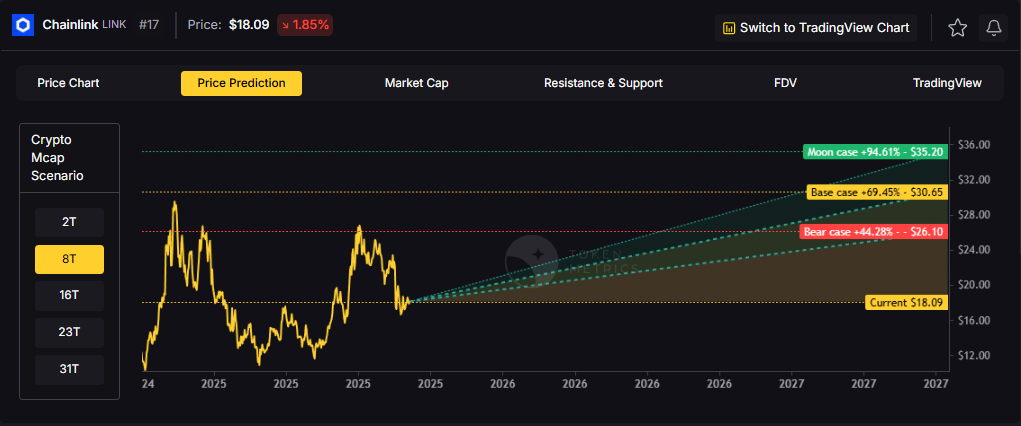
16T: Doubling the market to 16 trillion expands the range to $42.64 (bear), $56.29 (base), and $69.95 (moon).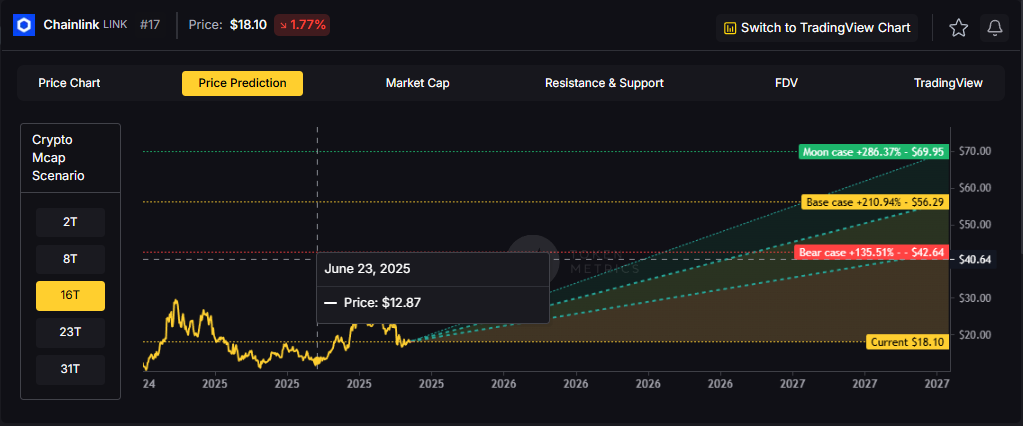
23T: At 23 trillion, the scenarios show $59.18, $81.94, and $104.70 respectively.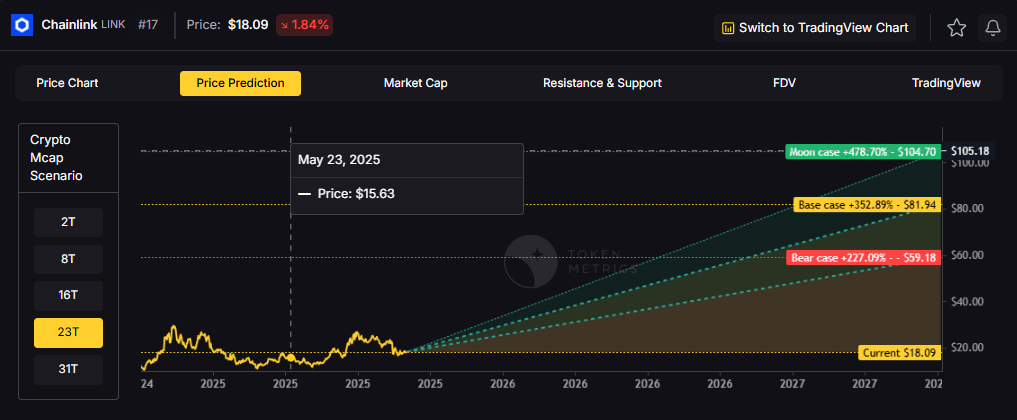
31T: In the maximum liquidity scenario of 31 trillion, LINK could reach $75.71 (bear), $107.58 (base), or $139.44 (moon).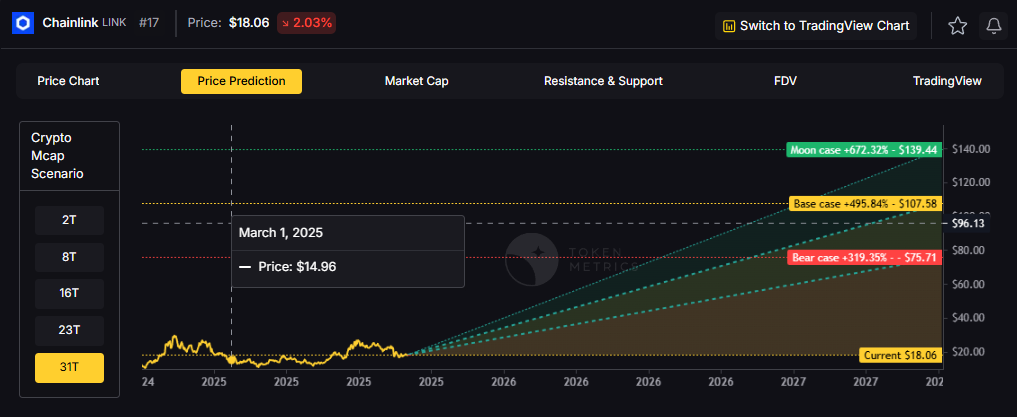
Chainlink represents one opportunity among hundreds in crypto markets. Token Metrics Indices bundle LINK with top one hundred assets for systematic exposure to the strongest projects. Single tokens face idiosyncratic risks that diversified baskets mitigate.
Historical index performance demonstrates the value of systematic diversification versus concentrated positions.
Chainlink is a decentralized oracle network that connects smart contracts to real-world data and systems. It enables secure retrieval and verification of off-chain information, supports computation, and integrates across multiple blockchains. As adoption grows, Chainlink serves as critical infrastructure for reliable data feeds and automation.
The LINK token is used to pay node operators and secure the network’s services. Common use cases include DeFi price feeds, insurance, and enterprise integrations, with CCIP extending cross-chain messaging and token transfers.
Vision: Chainlink aims to create a decentralized, secure, and reliable network for connecting smart contracts with real-world data and systems. Its vision is to become the standard for how blockchains interact with external environments, enabling trust-minimized automation across industries.
Problem: Smart contracts cannot natively access data outside their blockchain, limiting their functionality. Relying on centralized oracles introduces single points of failure and undermines the security and decentralization of blockchain applications. This creates a critical need for a trustless, tamper-proof way to bring real-world information onto blockchains.
Solution: Chainlink solves this by operating a decentralized network of node operators that fetch, aggregate, and deliver data from off-chain sources to smart contracts. It uses cryptographic proofs, reputation systems, and economic incentives to ensure data integrity. The network supports various data types and computation tasks, allowing developers to build complex, data-driven decentralized applications.
Market Analysis: Chainlink is a market leader in the oracle space and a key infrastructure component in the broader blockchain ecosystem, particularly within Ethereum and other smart contract platforms. It faces competition from emerging oracle networks like Band Protocol and API3, but maintains a strong first-mover advantage and widespread integration across DeFi, NFTs, and enterprise blockchain solutions. Adoption is driven by developer activity, partnerships with major blockchain projects, and demand for secure data feeds. Key risks include technological shifts, regulatory scrutiny on data providers, and execution challenges in scaling decentralized oracle networks. As smart contract usage grows, so does the potential for oracle services, positioning Chainlink at the center of a critical niche, though its success depends on maintaining security and decentralization over time.
Fundamental Grade: 74.58% (Community 81%, Tokenomics 100%, Exchange 100%, VC —, DeFi Scanner 17%).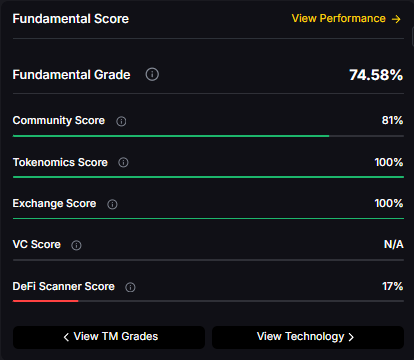
Technology Grade: 88.50% (Activity 81%, Repository 72%, Collaboration 100%, Security 86%, DeFi Scanner 17%).
Can LINK reach $100?
Yes. Based on the scenarios, LINK could reach $100+ in the 23T moon case. The 23T tier projects $104.70 in the moon case. Not financial advice.
What price could LINK reach in the moon case?
Moon case projections range from $35.20 at 8T to $139.44 at 31T. These scenarios assume maximum liquidity expansion and strong Chainlink adoption. Not financial advice.
Should I buy LINK now or wait?
Timing depends on risk tolerance and macro outlook. Current price of $18.09 sits below the 8T bear case in the scenarios. Dollar-cost averaging may reduce timing risk. Not financial advice.
Track live grades and signals: Token Details
Want exposure? Buy LINK on MEXC
Disclosure
Educational purposes only, not financial advice. Crypto is volatile, do your own research and manage risk.
Discover the full potential of your crypto research and portfolio management with Token Metrics. Our ratings combine AI-driven analytics, on-chain data, and decades of investing expertise—giving you the edge to navigate fast-changing markets. Try our platform to access scenario-based price targets, token grades, indices, and more for institutional and individual investors. Token Metrics is your research partner through every crypto market cycle.
%201.svg)
%201.svg)
The crypto market is tilting bullish into 2026 as liquidity, infrastructure, and participation improve across the board. Clearer rules and standards are reshaping the classic four-year cycle, flows can arrive earlier, and strength can persist longer than in prior expansions.
Institutional access is widening through ETFs and custody, while L2 scaling and real-world integrations help sustain on‑chain activity. This healthier backdrop frames our scenario work for HYPE. The ranges below reflect different total crypto market sizes and the share Hyperliquid could capture under each regime.
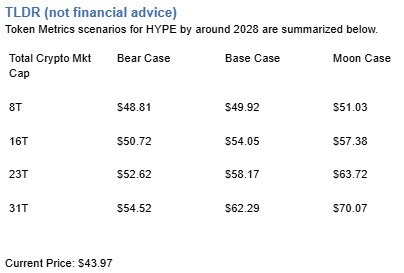
Disclosure
Educational purposes only, not financial advice. Crypto is volatile, do your own research and manage risk.
How to read it: Each band blends cycle analogues and market-cap share math with TA guardrails. Base assumes steady adoption and neutral or positive macro. Moon layers in a liquidity boom. Bear assumes muted flows and tighter liquidity.
TM Agent baseline: Token Metrics TM Grade is 73.9%, a Buy, and the trading signal is bearish, indicating short-term downward momentum. This means Token Metrics judges HYPE as fundamentally attractive over the long term, while near-term momentum is negative and may limit rallies.
Live details: Hyperliquid Token Details
Affiliate Disclosure: We may earn a commission from qualifying purchases made via this link, at no extra cost to you.
Scenario Analysis
Token Metrics scenarios span four market cap tiers, each representing different levels of crypto market maturity and liquidity:
8T: At an 8 trillion dollar total crypto market cap, HYPE projects to $48.81 in bear conditions, $49.92 in the base case, and $51.03 in bullish scenarios.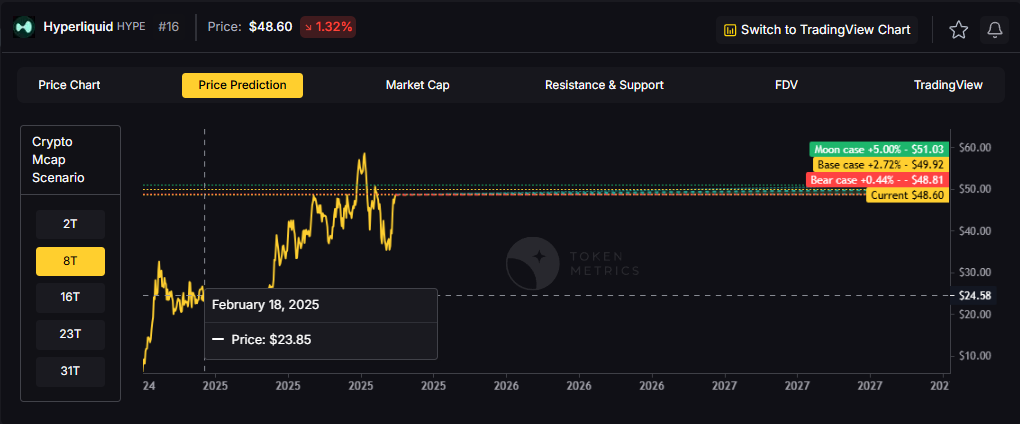
16T: Doubling the market to 16 trillion expands the range to $50.72 (bear), $54.05 (base), and $57.38 (moon).
23T: At 23 trillion, the scenarios show $52.62, $58.17, and $63.72 respectively.
31T: In the maximum liquidity scenario of 31 trillion, HYPE could reach $54.52 (bear), $62.29 (base), or $70.07 (moon).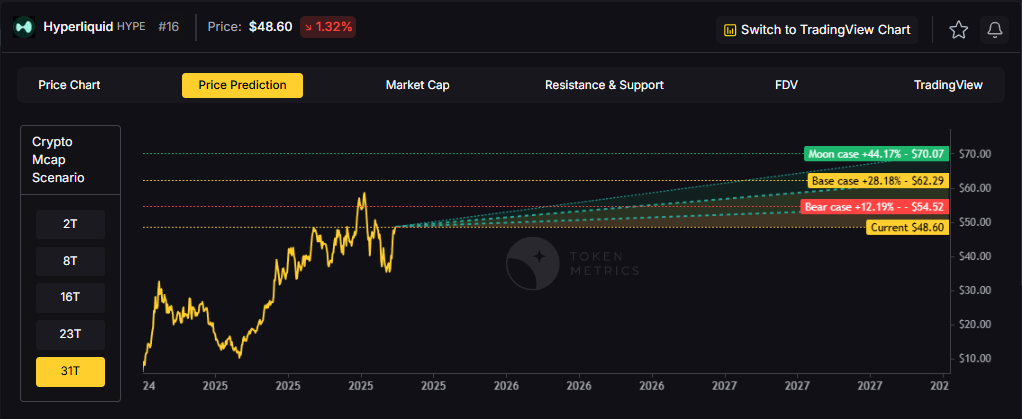
Each tier assumes progressively stronger market conditions, with the base case reflecting steady growth and the moon case requiring sustained bull market dynamics.
Diversification matters. HYPE is compelling, yet concentrated bets can be volatile. Token Metrics Indices hold HYPE alongside the top one hundred tokens for broad exposure to leaders and emerging winners.
Our backtests indicate that owning the full market with diversified indices has historically outperformed both the total market and Bitcoin in many regimes due to diversification and rotation.
Hyperliquid is a decentralized exchange focused on perpetual futures with a high-performance order book architecture. The project emphasizes low-latency trading, risk controls, and capital efficiency aimed at professional and retail derivatives traders. Its token, HYPE, is used for ecosystem incentives and governance-related utilities.
Can HYPE reach $60?
Yes, the 23T and 31T tiers imply ranges above $60 in the Base and Moon bands, though outcomes depend on liquidity and adoption. Not financial advice.
Is HYPE a good long-term investment?
Outcome depends on adoption, liquidity regime, competition, and supply dynamics. Diversify and size positions responsibly.
Disclosure
Educational purposes only, not financial advice. Crypto is volatile, do your own research and manage risk.
Token Metrics delivers AI-based crypto ratings, scenario projections, and portfolio tools so you can make smarter decisions. Discover real-time analytics on Token Metrics.
%201.svg)
%201.svg)
The Layer 1 competitive landscape is consolidating as markets recognize that specialization matters more than being a generic "Ethereum killer." Cardano positions itself in this multi-chain world with specific technical and ecosystem advantages. Infrastructure maturity around custody, bridges, and developer tools makes alternative L1s more accessible heading into 2026.
The scenario projections below map different market share outcomes for ADA across varying total crypto market sizes. Base cases assume Cardano maintains current ecosystem momentum, while moon scenarios factor in accelerated adoption and bear cases reflect increased competitive pressure.

Disclosure
Educational purposes only, not financial advice. Crypto is volatile, do your own research and manage risk.
How to read it: Each band blends cycle analogues and market-cap share math with TA guardrails. Base assumes steady adoption and neutral or positive macro. Moon layers in a liquidity boom. Bear assumes muted flows and tighter liquidity.
TM Agent baseline: Token Metrics lead metric for Cardano, cashtag $ADA, is a TM Grade of 29.72%, which translates to a Sell, and the trading signal is bearish, indicating short-term downward momentum. This combination means Token Metrics does not currently endorse $ADA as a long-term buy at current levels. A brief market context: Bitcoin's direction remains the dominant macro driver for smart contract platforms, so sustained upside for $ADA would require a broader crypto risk-on regime and improving fundamentals or developer activity for Cardano.
Live details: Cardano Token Details
Affiliate Disclosure: We may earn a commission from qualifying purchases made via this link, at no extra cost to you.
Token Metrics scenarios span four market cap tiers, each representing different levels of crypto market maturity and liquidity:




Each tier assumes progressively stronger market conditions, with the base case reflecting steady growth and the moon case requiring sustained bull market dynamics.
Cardano represents one opportunity among hundreds in crypto markets. Token Metrics Indices bundle ADA with top one hundred assets for systematic exposure to the strongest projects. Single tokens face idiosyncratic risks that diversified baskets mitigate.
Historical index performance demonstrates the value of systematic diversification versus concentrated positions.
Cardano is a blockchain platform designed to support secure, scalable, and sustainable decentralized applications and smart contracts. It is known for its research-driven development approach, emphasizing peer-reviewed academic research and formal verification methods to ensure reliability and security. As a proof-of-stake Layer 1 blockchain, Cardano aims to offer energy efficiency and long-term scalability, positioning itself as a competitor to platforms like Ethereum. Its native token, ADA, is used for transactions, staking, and governance. Adoption is driven by technological rigor and ecosystem growth, though progress has been criticized for being slow compared to more agile competitors. Risks include execution delays, competition, and market volatility.
Cardano’s vision is to create a decentralized platform that enables sustainable and inclusive economic systems through advanced cryptography and scientific methodology. It aims to bridge gaps between traditional financial systems and blockchain technology, promoting accessibility and security for users globally.
Token Metrics AI provides comprehensive context on Cardano's positioning and challenges.


Can ADA reach $4?
Based on the scenarios, ADA could reach $4 in the 31T moon case. The 31T tier projects $4.27 in the moon case. Not financial advice.
Can ADA 10x from current levels?
At current price of $0.65, a 10x would reach $6.50. This falls within none of the provided scenarios, which top out at $4.27 in the 31T moon case. Bear in mind that 10x returns require substantial market cap expansion. Not financial advice.
What price could ADA reach in the moon case?
Moon case projections range from $1.16 at 8T to $4.27 at 31T. These scenarios assume maximum liquidity expansion and strong Cardano adoption. Not financial advice.
Disclosure
Educational purposes only, not financial advice. Crypto is volatile, do your own research and manage risk.

%201.svg)
%201.svg)
Solana has emerged as one of the notable projects in the blockchain ecosystem, known for its high-performance capabilities and growing developer community. Understanding how to buy Solana (SOL) requires familiarity with the ecosystem, secure wallets, and the exchanges where the token is available. This guide presents an educational overview on acquiring Solana tokens while highlighting the tools and approaches that can support your research process efficiently.
Before proceeding with any acquisition, it helps to understand the fundamentals of the Solana blockchain. Solana is a decentralized network designed to enable fast, scalable decentralized applications (dApps) and crypto assets. Its native token, SOL, is used for transaction fees and interacting with applications on the network.
Awareness of Solana's technological framework, including its unique Proof of History consensus mechanism, provides context that informs the buying process from both a technical standpoint and an operational perspective.
Acquiring SOL tokens necessitates having a compatible wallet that supports Solana’s blockchain.
Choosing a wallet depends on individual preferences balancing convenience and security considerations.
SOL tokens are available on multiple cryptocurrency exchanges, but purchasing involves selecting a platform based on liquidity, fees, regulatory compliance, and user experience.
Common exchange options include:
Researching exchange reputation, fee structures, and security protocols is an important step and can be supplemented by analysis tools.
Utilizing AI-powered research platforms enhances the ability to analyze blockchain projects systematically. Token Metrics is one such platform offering data-driven insights, ratings, and scenario analyses. These tools help decode market trends, evaluate fundamentals, and monitor technical developments, supporting an informed understanding of Solana’s evolving landscape.
While such platforms provide valuable educational support, users should integrate various sources and maintain ongoing research to navigate the dynamic crypto environment responsibly.
When buying Solana or any cryptocurrency, security is paramount. Consider the following precautions:
Acquiring Solana tokens involves understanding the blockchain’s underlying technology, selecting the right wallet, choosing a reliable exchange, and practicing robust security measures. Leveraging AI-powered analytical tools like Token Metrics can deepen research capabilities and facilitate a comprehensive approach to exploring the crypto space.
This content is provided solely for educational and informational purposes. It is not financial, investment, tax, or legal advice. Readers should perform their own research and consult with licensed professionals before making any financial decisions related to cryptocurrencies.

%201.svg)
%201.svg)
Ethereum is one of the most influential blockchain platforms developed since Bitcoin. It extends the concept of a decentralized ledger by integrating a programmable layer that enables developers to build decentralized applications (dApps) and smart contracts. This blog post explores how Ethereum operates technically and functionally without delving into investment aspects.
At its core, Ethereum operates as a distributed ledger technology—an immutable blockchain maintained by a decentralized network of nodes. These nodes collectively maintain and validate the Ethereum blockchain, which records every transaction and smart contract execution.
The Ethereum blockchain differs from Bitcoin primarily through its enhanced programmability and faster block times. Ethereum’s block time averages around 12-15 seconds, which allows for quicker confirmation of transactions and execution of contracts.
A fundamental innovation introduced by Ethereum is the smart contract. Smart contracts are self-executing pieces of code stored on the blockchain, triggered automatically when predefined conditions are met.
The Ethereum Virtual Machine (EVM) is the runtime environment for smart contracts. It interprets the contract code and operates across all Ethereum nodes to ensure consistent execution. This uniformity enforces the trustless and decentralized nature of applications built on Ethereum.
Originally, Ethereum used a Proof of Work (PoW) consensus mechanism similar to Bitcoin, requiring miners to solve complex cryptographic puzzles to confirm transactions and add new blocks. However, Ethereum has transitioned to Proof of Stake (PoS) through an upgrade called Ethereum 2.0.
In the PoS model, validators are chosen to propose and validate blocks based on the amount of cryptocurrency they stake as collateral. This method reduces energy consumption and improves scalability and network security.
Executing transactions and running smart contracts on Ethereum requires computational resources. These are measured in units called gas. Users pay gas fees, denominated in Ether (ETH), to compensate validators for processing and recording the transactions.
The gas fee varies depending on network demand and the complexity of the operation. Simple transactions require less gas, while complex contracts or high congestion periods incur higher fees. Gas mechanics incentivize efficient code and prevent spam on the network.
Ethereum’s decentralization is maintained by nodes located worldwide. These nodes can be categorized as full nodes, which store the entire blockchain and validate all transactions, and light nodes, which store only essential information.
Anyone can run a node, contributing to Ethereum’s resilience and censorship resistance. Validators in PoS must stake Ether to participate in block validation, ensuring alignment of incentives for network security.
Decentralized applications (dApps) are built on Ethereum’s infrastructure. These dApps span various sectors, including decentralized finance (DeFi), supply chain management, gaming, and digital identity. The open-source nature of Ethereum encourages innovation and interoperability across platforms.
Understanding Ethereum’s intricate network requires access to comprehensive data and analytical tools. AI-driven platforms, such as Token Metrics, utilize machine learning to evaluate on-chain data, developer activity, and market indicators to provide in-depth insights.
Such platforms support researchers and users by offering data-backed analysis, helping to comprehend Ethereum’s evolving technical landscape and ecosystem without bias or financial recommendations.
Ethereum revolutionizes blockchain technology by enabling programmable, trustless applications through smart contracts and a decentralized network. Transitioning to Proof of Stake enhances its scalability and sustainability. Understanding its mechanisms—from the EVM to gas fees and network nodes—provides critical perspectives on its operation.
For those interested in detailed Ethereum data and ratings, tools like Token Metrics offer analytical resources driven by AI and machine learning to keep pace with Ethereum’s dynamic ecosystem.
This content is for educational and informational purposes only. It does not constitute financial, investment, or trading advice. Readers should conduct independent research and consult professionals before making decisions related to cryptocurrencies or blockchain technologies.

%201.svg)
%201.svg)
Ethereum mining has been an essential part of the Ethereum blockchain network, enabling transaction validation and new token issuance under a Proof-of-Work (PoW) consensus mechanism. As Ethereum evolves, understanding the fundamentals of mining, the required technology, and operational aspects can provide valuable insights into this cornerstone process. This guide explains the key components of Ethereum mining, focusing on technical and educational details without promotional or financial advice.
Ethereum mining involves validating transactions and securing the network by solving complex mathematical problems using computational resources. Miners employ high-performance hardware to perform hashing calculations and compete to add new blocks to the blockchain. Successfully mined blocks reward miners with Ether (ETH) generated through block rewards and transaction fees.
At its core, Ethereum mining requires:
GPU-based mining rigs are currently the standard hardware for Ethereum mining due to their efficiency in processing the Ethash PoW algorithm. Graphics Processing Units (GPUs) are well-suited for the memory-intensive hashing tasks required for Ethereum, as opposed to ASICs (Application-Specific Integrated Circuits) that tend to specialize in other cryptocurrencies.
Key considerations when selecting GPUs include:
Popular GPUs such as the Nvidia RTX and AMD RX series often top mining performance benchmarks. However, hardware availability and electricity costs significantly impact operational efficiency.
Once mining hardware is selected, the next step involves configuring mining software suited for Ethereum. Mining software translates computational tasks into actionable processes executed by the hardware while connecting to the Ethereum network or mining pools.
Common mining software options include:
When configuring mining software, consider settings related to:
Mining Ethereum independently can be challenging due to increasing network difficulty and competition. Mining pools provide cooperative frameworks where multiple miners combine computational power to improve chances of mining a block. Rewards are then distributed proportionally according to contributed hash power.
Benefits of mining pools include:
Popular mining pools for Ethereum include Ethermine, SparkPool, and Nanopool. When selecting a mining pool, evaluate factors such as fees, payout methods, server locations, and minimum payout thresholds.
Mining Ethereum incurs ongoing costs, primarily electricity consumption and hardware maintenance. Efficiency optimization entails balancing power consumption with mining output to ensure sustainable operations.
Key factors to consider include:
Understanding power consumption (wattage) of mining rigs relative to their hashrate assists in determining energy efficiency. For example, a rig with a hashrate of 60 MH/s consuming 1200 watts has different efficiency metrics compared to others.
Efficient mining operations benefit from monitoring tools that track hardware performance, network status, and market dynamics. Analytical platforms offer data-backed insights that can guide equipment upgrades, pool selection, and operational adjustments.
Artificial intelligence-driven research platforms like Token Metrics provide quantitative analysis of Ethereum network trends and mining considerations. Leveraging such tools can optimize decision-making by integrating technical data with market analytics without endorsing specific investment choices.
Ethereum’s transition from Proof-of-Work to Proof-of-Stake (PoS), known as Ethereum 2.0, represents a significant development that impacts mining practices. PoS eliminates traditional mining in favor of staking mechanisms, which means Ethereum mining as performed today may phase out.
Miners should remain informed about network upgrades and consensus changes through official channels and reliable analysis platforms like Token Metrics. Understanding potential impacts enables strategic planning related to hardware usage and participation in alternative blockchain activities.
This article is intended for educational purposes only. It does not offer investment advice, price predictions, or endorsements. Readers should conduct thorough individual research and consider multiple reputable sources before engaging in Ethereum mining or related activities.

%201.svg)
%201.svg)
The digital landscape is continually evolving, giving rise to a new paradigm known as Web 3. This iteration promises a shift towards decentralization, enhanced user control, and a more immersive internet experience. But what exactly is Web 3, and why is it considered a transformative phase of the internet? This article explores its fundamentals, technology, potential applications, and the tools available to understand this complex ecosystem.
Web 3, often referred to as the decentralized web, represents the next generation of internet technology that aims to move away from centralized platforms dominated by a few major organizations. Instead of relying on centralized servers, Web 3 utilizes blockchain technology and peer-to-peer networks to empower users and enable trustless interactions.
In essence, Web 3 decentralizes data ownership and governance, allowing users to control their information and digital assets without intermediaries. This marks a significant departure from Web 2.0, where data is predominantly managed by centralized corporations.
Several emerging technologies underpin the Web 3 movement, each playing a vital role in achieving its vision:
Together, these technologies provide a robust foundation for a more autonomous and transparent internet landscape.
Understanding Web 3 requires comparing it to its predecessor, Web 2:
This shift fosters a more user-centric, permissionless, and transparent internet experience.
Web 3's decentralized infrastructure unlocks numerous application possibilities across industries:
As Web 3 matures, the range of practical and innovative use cases is expected to expand further.
Despite its promise, Web 3 faces several hurdles that need attention:
Addressing these challenges is crucial for realizing the full potential of Web 3.
For individuals and organizations interested in understanding Web 3 developments, adopting a structured research approach is beneficial:
This approach supports informed analysis based on technology fundamentals rather than speculation.
Artificial intelligence technologies complement Web 3 by enhancing research and analytical capabilities. AI-driven platforms can process vast amounts of blockchain data to identify patterns, assess project fundamentals, and forecast potential developments.
For example, Token Metrics integrates AI methodologies to provide insightful ratings and reports on various Web 3 projects and tokens. Such tools facilitate more comprehensive understanding for users navigating decentralized ecosystems.
Web 3 embodies a transformative vision for the internet—one that emphasizes decentralization, user empowerment, and innovative applications across multiple sectors. While challenges remain, its foundational technologies like blockchain and smart contracts hold substantial promise for reshaping digital interactions.
Continuing research and utilization of advanced analytical tools like Token Metrics can help individuals and organizations grasp Web 3’s evolving landscape with clarity and rigor.
This article is for educational and informational purposes only and does not constitute financial, investment, or legal advice. Readers should conduct their own research and consult with professional advisors before making any decisions related to Web 3 technologies or digital assets.

%201.svg)
%201.svg)
The explosion of interest in non-fungible tokens (NFTs) has opened new opportunities for creators and collectors alike. If you've ever wondered, "How can I mint my own NFT?", this guide will walk you through the essential concepts, processes, and tools involved in creating your unique digital asset on the blockchain.
Minting an NFT refers to the process of turning a digital file — such as artwork, music, video, or other digital collectibles — into a unique token recorded on a blockchain. This tokenization certifies the originality and ownership of the asset in a verifiable manner. Unlike cryptocurrencies, NFTs are unique and cannot be exchanged on a one-to-one basis.
Several blockchains support NFT minting, each with distinct features, costs, and communities. The most popular blockchain for NFTs has been Ethereum due to its widespread adoption and support for ERC-721 and ERC-1155 token standards. However, alternatives such as Binance Smart Chain, Solana, Polygon, and Tezos offer different advantages, such as lower transaction fees or faster processing times.
When deciding where to mint your NFT, consider factors like network fees (also known as gas fees), environmental impact, and marketplace support. Analytical tools, including Token Metrics, can offer insights into blockchain performance and trends, helping you make an informed technical decision.
Once you have chosen a blockchain, the next step is to select an NFT platform that facilitates minting and listing your digital asset. Popular NFT marketplaces such as OpenSea, Rarible, Foundation, and Mintable provide user-friendly interfaces to upload digital files, set metadata, and mint tokens.
Some platforms have specific entry requirements, such as invitation-only access or curation processes, while others are open to all creators. Consider the platform's user base, fees, minting options (e.g., lazy minting or direct minting), and supported blockchains before proceeding.
Minting an NFT typically involves transaction fees known as gas fees, which vary based on blockchain network congestion and platform policies. Costs can fluctuate significantly; therefore, it's prudent to monitor fee trends, potentially using analytical resources like Token Metrics to gain visibility into network conditions.
Some NFT platforms offer "lazy minting," allowing creators to mint NFTs with zero upfront fees, with costs incurred only upon sale. Understanding these financial mechanics is crucial to planning your minting process efficiently.
The intersection of artificial intelligence and blockchain has produced innovative tools that assist creators and collectors throughout the NFT lifecycle. AI can generate creative artwork, optimize metadata, and analyze market trends to inform decisions.
Research platforms such as Token Metrics utilize AI-driven methodologies to provide data insights and ratings that support neutral, analytical understanding of blockchain assets, including aspects relevant to NFTs. Employing such tools can help you better understand the technical fundamentals behind NFT platforms and ecosystems.
Minting your own NFT involves understanding the technical process of creating a unique token on a blockchain, choosing appropriate platforms, managing costs, and utilizing supporting tools. While the process is accessible to many, gaining analytical insights and leveraging AI-driven research platforms such as Token Metrics can deepen your understanding of underlying technologies and market dynamics.
This article is for educational purposes only and does not constitute financial or investment advice. Always conduct your own research and consult professionals before engaging in digital asset creation or transactions.

%201.svg)
%201.svg)
Centralized cryptocurrency exchanges have become the primary venues for trading a wide array of digital assets. Their user-friendly interfaces and liquidity pools make them appealing for both new and experienced traders. However, the inherent risks of using such centralized platforms warrant careful consideration. This article explores the risks associated with centralized exchanges, offering an analytical overview while highlighting valuable tools that can assist users in evaluating these risks.
Centralized exchanges (CEXs) operate as intermediaries that facilitate buying, selling, and trading cryptocurrencies. Users deposit funds into the exchange's custody and execute trades on its platform. Unlike decentralized exchanges, where users maintain control of their private keys and assets, centralized exchanges hold users' assets on their behalf, which introduces specific vulnerabilities and considerations.
One of the primary risks associated with centralized exchanges is security vulnerability. Holding large sums of digital assets in a single entity makes exchanges prominent targets for hackers. Over the years, numerous high-profile breaches have resulted in the loss of millions of dollars worth of crypto assets. These attacks often exploit software vulnerabilities, insider threats, or phishing campaigns.
Beyond external hacking attempts, users must be aware of the risks posed by potential internal malfeasance within these organizations. Since exchanges control private keys to user assets, trust in their operational security and governance practices is critical.
Using centralized exchanges means users relinquish direct control over their private keys. This custodial arrangement introduces counterparty risk, fundamentally differing from holding assets in self-custody wallets. In situations of insolvency, regulatory intervention, or technical failures, users may face difficulties accessing or retrieving their funds.
Additionally, the lack of comprehensive insurance coverage on many platforms means users bear the brunt of potential losses. The concept "not your keys, not your coins" encapsulates this risk, emphasizing that asset ownership and control are distinct on centralized platforms.
Centralized exchanges typically operate under jurisdictional regulations which can vary widely. Regulatory scrutiny may lead to sudden operational restrictions, asset freezes, or delisting of certain cryptocurrencies. Users of these platforms should be aware that regulatory changes can materially impact access to their assets.
Furthermore, compliance requirements such as Know Your Customer (KYC) and Anti-Money Laundering (AML) procedures involve sharing personal information, posing privacy considerations. Regulatory pressures could also compel exchanges to surveil or restrict user activities.
Large centralized exchanges generally offer high liquidity, facilitating quick trade execution. However, liquidity can vary significantly between platforms and tokens, possibly leading to slippage or failed orders during volatile conditions. In extreme scenarios, liquidity crunches may limit the ability to convert assets efficiently.
Moreover, centralized control over order books and matching engines means that trade execution transparency is limited compared to decentralized protocols. Users should consider market structure risks when interacting with centralized exchanges.
System outages, software bugs, or maintenance periods pose operational risks on these platforms. Unexpected downtime can prevent users from acting promptly in dynamic markets. Moreover, technical glitches could jeopardize order accuracy, deposits, or withdrawals.
Best practices involve users staying informed about platform status and understanding terms of service that govern incident responses. Awareness of past incidents can factor into decisions about trustworthiness.
While the risks highlighted are inherent to centralized exchanges, utilizing advanced research and analytical tools can enhance users’ understanding and management of these exposures. AI-driven platforms like Token Metrics offer data-backed insights into exchange security practices, regulatory compliance, liquidity profiles, and overall platform reputation.
Such tools analyze multiple risk dimensions using real-time data, historical performance, and fundamental metrics. This structured approach allows users to make informed decisions based on factual assessments rather than anecdotal information.
Additionally, users can monitor news, community sentiment, and technical analytics collectively via these platforms to evaluate evolving conditions that may affect centralized exchange risk profiles.
Centralized cryptocurrency exchanges continue to play a significant role in digital asset markets, providing accessibility and liquidity. Nevertheless, they carry multifaceted risks ranging from security vulnerabilities to regulatory uncertainties and operational challenges. Understanding these risks through a comprehensive analytical framework is crucial for all participants.
Non-investment-focused, AI-driven research platforms like Token Metrics can support users in navigating the complexity of exchange risks by offering systematic, data-driven insights. Combining such tools with prudent operational practices paves the way for more informed engagement with centralized exchanges.
This content is provided solely for educational and informational purposes. It does not constitute financial, investment, or legal advice. Readers should conduct their own research and consult qualified professionals before making any financial decisions.

%201.svg)
%201.svg)
The landscape of digital assets and blockchain technology has expanded rapidly over recent years, bringing forth a new realm known as Web3 alongside the burgeoning crypto ecosystem. For individuals curious about allocating resources into this sphere, questions often arise: should the focus be on cryptocurrencies or Web3 companies? This article aims to provide an educational and analytical perspective on these options, highlighting considerations without providing direct investment advice.
Before exploring the nuances between investing in crypto assets and Web3 companies, it's important to clarify what each represents.
Web3 companies often develop decentralized applications (dApps), offer blockchain-based services, or build infrastructure layers for the decentralized web.
Deciding between crypto assets or Web3 companies involves analyzing different dynamics:
To approach these complex investment types thoughtfully, frameworks can assist in structuring analysis:
Due to the rapidly evolving and data-intensive nature of crypto and Web3 industries, AI-powered platforms can enhance analysis by processing vast datasets and providing insights.
For instance, Token Metrics utilizes machine learning to rate crypto assets by analyzing market trends, project fundamentals, and sentiment data. Such tools support an educational and neutral perspective by offering data-driven research support rather than speculative advice.
When assessing Web3 companies, AI tools can assist with identifying emerging technologies, tracking developmental progress, and monitoring regulatory developments relevant to the decentralized ecosystem.
To gain a well-rounded understanding, consider the following steps:
Both crypto assets and Web3 companies involve unique risks that warrant careful consideration:
Deciding between crypto assets and Web3 companies involves analyzing different dimensions including technological fundamentals, market dynamics, and risk profiles. Employing structured evaluation frameworks along with AI-enhanced research platforms such as Token Metrics can provide clarity in this complex landscape.
It is essential to approach this domain with an educational mindset focused on understanding rather than speculative intentions. Staying informed and leveraging analytical tools supports sound comprehension of the evolving world of blockchain-based digital assets and enterprises.
This article is intended for educational purposes only and does not constitute financial, investment, or legal advice. Readers should conduct their own research and consult with professional advisors before making any decisions related to cryptocurrencies or Web3 companies.

%201.svg)
%201.svg)
The evolution from Web2 to Web3 marks a significant paradigm shift in how we interact with digital services. While Web2 platforms have delivered intuitive and seamless user experiences, Web3—the decentralized internet leveraging blockchain technology—still faces considerable user experience (UX) challenges. This article explores the reasons behind the comparatively poor UX in Web3 and the technical, design, and infrastructural hurdles contributing to this gap.
Web2 represents the current mainstream internet experience characterized by centralized servers, interactive social platforms, and streamlined services. Its UX benefits from consistent standards, mature design patterns, and direct control over data.
In contrast, Web3 aims at decentralization, enabling peer-to-peer interactions through blockchain protocols, decentralized applications (dApps), and user-owned data ecosystems. While promising increased privacy and autonomy, Web3 inherently introduces complexity in UX design.
Several intrinsic technical barriers impact the Web3 user experience:
The nascent nature of Web3 results in inconsistent and sometimes opaque design standards:
Web2 giants have invested billions over decades fostering developer communities, design systems, and customer support infrastructure. In contrast, Web3 is still an emerging ecosystem characterized by:
Such factors contribute to a user experience that feels fragmented and inaccessible to mainstream audiences.
Emerging tools powered by artificial intelligence and data analytics can help mitigate some UX challenges in Web3 by:
Integrating such AI-driven research and analytic tools enables developers and users to progressively enhance Web3 usability.
For users trying to adapt to Web3 environments, the following tips may help:
For developers, focusing on the following can improve UX outcomes:
The current disparity between Web3 and Web2 user experience primarily stems from decentralization complexities, immature design ecosystems, and educational gaps. However, ongoing innovation in AI-driven analytics, comprehensive rating platforms like Token Metrics, and community-driven UX improvements are promising. Over time, these efforts could bridge the UX divide to make Web3 more accessible and user-friendly for mainstream adoption.
This article is for educational and informational purposes only and does not constitute financial advice or an endorsement. Users should conduct their own research and consider risks before engaging in any blockchain or cryptocurrency activities.

%201.svg)
%201.svg)
Smart contracts have become an integral part of blockchain technology, enabling automated, trustless agreements across various platforms. Understanding what languages are used for smart contract development is essential for developers entering this dynamic field, as well as for analysts and enthusiasts who want to deepen their grasp of blockchain ecosystems. This article offers an analytical and educational overview of popular programming languages for smart contract development, discusses their characteristics, and provides insights on how analytical tools like Token Metrics can assist in evaluating smart contract projects.
Smart contract languages are specialized programming languages designed to create logic that runs on blockchains. The most prominent blockchain for smart contracts currently is Ethereum, but other blockchains have their languages as well. The following section outlines some of the most widely-used smart contract languages.
Developers evaluate smart contract languages based on various factors such as security, expressiveness, ease of use, and compatibility with blockchain platforms. Below are some important criteria:
Solidity remains the dominant language due to Ethereum's market position and is well-suited for developers familiar with JavaScript or object-oriented paradigms. It continuously evolves with community input and protocol upgrades.
Vyper has a smaller user base but appeals to projects requiring stricter security standards, as its design deliberately omits complex features that increase vulnerabilities.
Rust is leveraged by newer chains that aim to combine blockchain decentralization with high throughput and low latency. Developers familiar with systems programming find Rust a robust choice.
Michelson’s niche is in formal verification-heavy projects where security is paramount, such as financial contracts and governance mechanisms on Tezos.
Move and Clarity represent innovative approaches to contract safety and complexity management, focusing on deterministic execution and resource constraints.
Artificial Intelligence (AI) and machine learning have become increasingly valuable in analyzing and researching blockchain projects, including smart contracts. Platforms such as Token Metrics provide AI-driven ratings and insights by analyzing codebases, developer activity, and on-chain data.
Such tools facilitate the identification of patterns that might indicate strong development practices or potential security risks. While they do not replace manual code audits or thorough research, they support investors and developers by presenting data-driven evaluations that help in filtering through numerous projects.
Developers choosing a smart contract language should consider the blockchain platform’s restrictions and the nature of the application. Those focused on DeFi might prefer Solidity or Vyper for Ethereum, while teams aiming for cross-chain applications might lean toward Rust or Move.
Analysts seeking to understand a project’s robustness can utilize resources like Token Metrics for AI-powered insights combined with manual research, including code reviews and community engagement.
Security should remain a priority as vulnerabilities in smart contract code can lead to significant issues. Therefore, familiarizing oneself with languages that encourage safer programming paradigms contributes to better outcomes.
Understanding what languages are used for smart contract development is key to grasping the broader blockchain ecosystem. Solidity leads the field due to Ethereum’s prominence, but alternative languages like Vyper, Rust, Michelson, Move, and Clarity offer different trade-offs in security, performance, and usability. Advances in AI-driven research platforms such as Token Metrics play a supportive role in evaluating the quality and safety of smart contract projects.
This article is intended for educational purposes only and does not constitute financial or investment advice. Readers should conduct their own research and consult professionals before making decisions related to blockchain technologies and smart contract development.


 Create Your Free Account
Create Your Free Account9450 SW Gemini Dr
PMB 59348
Beaverton, Oregon 97008-7105 US
.svg)




.png)
Token Metrics Media LLC is a regular publication of information, analysis, and commentary focused especially on blockchain technology and business, cryptocurrency, blockchain-based tokens, market trends, and trading strategies.
Token Metrics Media LLC does not provide individually tailored investment advice and does not take a subscriber’s or anyone’s personal circumstances into consideration when discussing investments; nor is Token Metrics Advisers LLC registered as an investment adviser or broker-dealer in any jurisdiction.
Information contained herein is not an offer or solicitation to buy, hold, or sell any security. The Token Metrics team has advised and invested in many blockchain companies. A complete list of their advisory roles and current holdings can be viewed here: https://tokenmetrics.com/disclosures.html/
Token Metrics Media LLC relies on information from various sources believed to be reliable, including clients and third parties, but cannot guarantee the accuracy and completeness of that information. Additionally, Token Metrics Media LLC does not provide tax advice, and investors are encouraged to consult with their personal tax advisors.
All investing involves risk, including the possible loss of money you invest, and past performance does not guarantee future performance. Ratings and price predictions are provided for informational and illustrative purposes, and may not reflect actual future performance.

